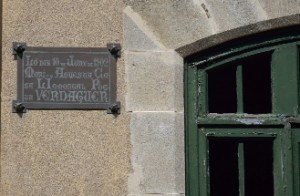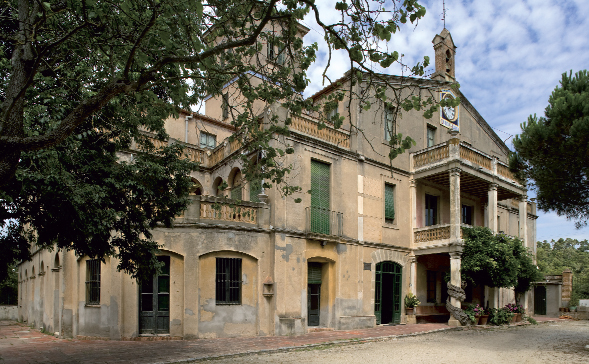Vil·la Joana in Vallvidrera, currently under restoration, will once again open its doors to the public in the spring of 2016 as a museum on the city’s literary heritage, with a strong focus on the great Catalan poet Jacint Verdaguer, and as a meeting place for different groups in the world of literature.
The MUHBA project Vil·la Joana-Verdaguer House of Literature sets out to illustrate the intense historic relationship that the city of Barcelona has with literary imagination and everything that derives from it: the academic perspectives, its social and ideological roles and the publishing world, and the birth of an imaginary world that is so very effective in the construction and projection of the city today.
The Vil·la Joana building, which is possibly built on late Medieval foundations, is a 17th century farmhouse in Vallvidrera, right at the heart of the Collserola mountain range. However, it acquired its current form in the late 19th century when it was owned by the Miralles family, who converted it into a summer house where they hosted the writer Jacint Verdaguer. Strong public consensus turned Vil·la Joana into Barcelona’s Casa Verdaguer, from the very moment the writer died in 1902. From 1920 and for half a century thereafter, Vil·la Joana also housed a groundbreaking school run by the Barcelona City Council for children with special needs, giving them access to language that was generally closed to them, just a short while after the house had been Verdaguer’s final refuge. Seven years ago, the Barcelona City History Museum (which, as part of its work to protect the city’s heritage and its story, pays particular attention to literary heritage) set out to convert the section housed in Vil·la Joana into the Verdaguer House of Literature. The site will re-open to the public in the spring of 2016 as a space that celebrates the value of the word, and of the written word in particular, and its unique capacity for symbolism and collectivism, fully incorporating it into Barcelona’s mainstream history.
The gallery spaces are located on the ground and first floors, following the plans drawn up by MUHBA and directed by Josep Maria Domingo with the support of Ramon Pinyol, Oriol Izquierdo and Cristina Masanés. A tour of the museum will provide an initial perspective on Barcelona from Vil·la Joana’s point of view, showing the building’s evolution from farmhouse to summer house, to special school and then, from 1962, to museum. The galleries then explore various aspects of literature, its global dimension and the place that Catalan literature has in it, the shift from writing to reading and contemporary literature described through the complex intellectual figure of Verdaguer, culminating in a portrait of Barcelona as a literary city.

Photo: Vicente Zambrano
The plaque that commemorates the death of Jacint Verdaguer at the farmhouse in Vallvidrera on June 10th, 1902
The initial approach looks at the notion of “world literature” because there are in fact many “world” literatures, in languages with many or few speakers, with works by men and by women, and written in different registers. This is one of the intentions of the Literàrium, a virtual and inevitably limited version of Borges’ infinite library that allows visitors to choose from some very diverse works of literature in the digital archives and see their significance in the big scheme of things. Following that is the space devoted to showing the world through the eyes of Catalan literature, from the Middle Ages to the present day.
The itinerary through the ground floor ends with a look at how the author’s creation of a text is then recreated by the reader. In the old school kitchen, this step from writing to reading is given a sensory approach. Through touch, taste, smell, sound and sight, visitors can explore how literature comes alive.
Verdaguer as a symbol
The visitors then move on to the first floor, where Verdaguer plays a leading role. In Western society, literature has played a crucial role over the last three centuries. From the Romantic period and throughout the 19th century, its craftsmen – authors – have been public figures of great significance. For Catalans, Verdaguer is the first great contemporary writer. His work and the vicissitudes of his life are a great example of the way society was transformed in the 19th century: we see the impact of industrialisation and migration from the countryside to the city, the expansion of the Eixample, the workers’ movements and Catalan nationalist uprisings, the gold rush, the ostentation of the well-off and the birth of mass culture.
But Verdaguer was not an exceptional case. As we pass through the galleries, we also discover the “Verdaguers of Europe”; writers who, like him, became symbols of their respective cultures. And through Verdaguer we also look at the uncomfortable relationship between the writer and the powers that be. “En defensa pròpia” (In My Own Defence) – written a year before Zola’s “J’accuse” – highlights Verdaguer’s dignity in the face of the campaign orchestrated against him by the bourgeois elite and the church authorities that he had served until then. The popularity of mossèn Cinto, as the priest was popularly known, is not surprising then; he even won respect in anarchist circles. His funeral attracted one of the biggest crowds the city has ever seen to this day.
The final section of the museum once again covers a broader spectrum and looks at the city and its authors, showing Barcelona as a publishing hub and the birthplace of the Sant Jordi festival, highlighting the crossover between the city and the life of so many authors who were born or lived here (Maragall, Sagarra, Rodoreda, Foix, Espriu, Marsé, the Goytisolo brothers, Vázquez Montalbán, Brossa, etc.) and of many others who have passed through. Barcelona itself has been and still is the subject of literature: a large audio-visual projection takes us on a journey through the works of authors from all over the world who have used the city as a theme or a setting and made it their own, and with that the visit comes to an end.
The second floor has been designed as an area for research and for the study of literary heritage from a historical and comparative perspective, in relation to literature’s role in the city’s history. There will be post-graduate courses, master’s courses and seminars held in partnership with various Catalan universities and institutes, in line with the work that MUHBA’s Research and Debate Centre has been carrying out for many years. These lines of research will be made accessible to the public and will contribute to a programme of public events.
Vil·la Joana is just a few minutes away from the city centre by public transport. As well as the museum visits and activities, a programme of events held mostly on Saturday and Sunday mornings is being planned. This programme will be similar to those of literary centres in other European cities, such as the Literaturhaus Berlin, with a special focus on the literary construction of modern cities. There will still be strong ties with other writers’ houses emanating Catalan literary culture, particularly the Casa Verdaguer in Folgueroles, and Vil·la Joana will continue to play an important role in the local area in cooperation with the Collserola Consortium. With a programme created together with organisations from other literary spheres from Barcelona and Catalonia, Vil·la Joana will become a meeting place for all those involved in historical study, literary creation and the publishing industry in Barcelona.




